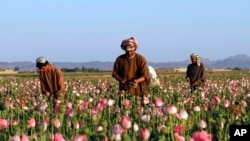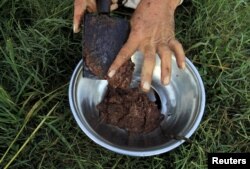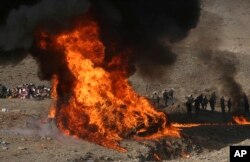A new United Nations survey finds that opium cultivation in Afghanistan has decreased by 20 percent in 2018 compared to the previous year, citing a severe drought and falling prices of dry opium at the national level.
The total opium-poppy cultivation area decreased to 263,000 hectares, from 328,000 hectares estimated in 2017, but it was
still the second highest measurement for Afghanistan since the U.N. Office on Drugs and Crime (UNODC) began monitoring in 1994.
The potential opium production decreased by 29 percent to 6,400 tons from an estimated 9,000 tons in 2017.
The UNODC country representative, Mark Colhoun, while explaining factors behind the reduction told reporters in Kabul the farm-gate prices of dry opium at the harvest time fell to $94 per kilogram, the lowest since 2004.
The decreases, in particular in the northern and western Afghan regions, were mainly attributed to the severe drought that hit the country during the course of the last year, he added.
“Despite these decreases, the overall area under opium-poppy cultivation is still the highest ever recorded. This is a clear challenge to security and safety for the region and beyond. It is also a threat to all countries to and through which these drugs are trafficked as well as to Afghanistan itself,” said Colhoun.
He warned that more high-quality low-cost heroin will reach consumer markets across the world, with increased consumption and related harms as a further likely consequence.
“The significant levels of opium-poppy cultivation and illicit trafficking of opiates will further fuel instability, insurgency and increase funding to terrorist groups in Afghanistan,” he said.
Colhoun noted that while there is no single explanation for the continuing high levels of opium-poppy cultivation, rule of law-related challenges such as political instability, lack of government control and security as well as corruption have been found to be among the main drivers of illicit cultivation.
The UNODC survey estimated that the total farm-gate value of opium production decreased by 56 percent to $604 million, which is equivalent to three percent of Afghanistan’s GDP, from $1.4 billion in 2017. The lowest prices strongly undermined the income earned from opium cultivation by farmers.
The study finds that 24 out of the 34 Afghan provinces grew the opium-poppy in 2018, the same number as in the previous year.
The survey found that 69 percent of the opium poppy cultivation took place in southern Afghanistan and the largest province of Helmand remained the leading opium-poppy cultivating region followed by neighboring Kandahar and Uruzgan and Nangarhar in the east.
It noted that opium poppy weeding and harvesting provided for the equivalent of up to 354,000 full-time jobs to rural areas in 2017.
A U.S. government agency, the Special Inspector General for Afghanistan Reconstruction (SIGAR), has noted in its latest report that as of September 30, Washington’s counternarcotics-related appropriations for the country had reached almost $9 billion.
"Despite the importance of the threat narcotics pose to reconstruction and despite massive expenditures for programs including poppy-crop eradication, drug seizures and interdictions, alternative-livelihood support, aviation support, and incentives for provincial governments, the drug trade remains entrenched in Afghanistan, and is growing," said Sigar, which monitors U.S. civilian and military spendings in the country.










